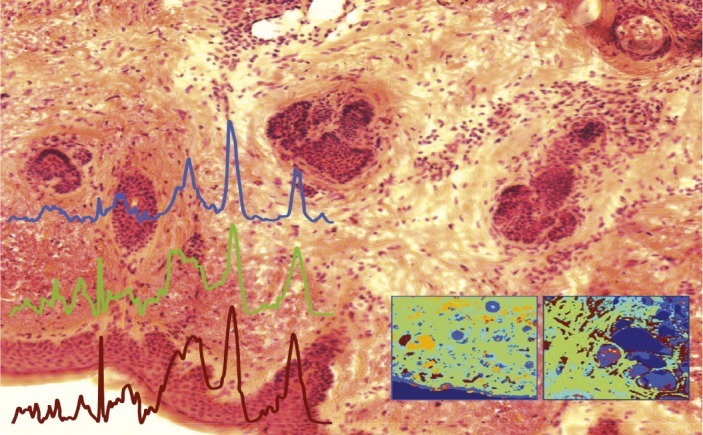Imaging tumors during surgery

Stained skin tissue sample and Raman spectra corresponding to BCC (brown), dermis (green), and sebaceous glands (blue).
Cancer diagnoses typically rely on histopathology, the microscopic examination of stained tissue sections. Histopathology can also be used to determine tumor margins in sequential layers of tissue excised during tissue-conserving surgery of nonmelanoma skin cancers, but the technique is too time consuming for most other cancer types. Conventional histopathology methods are also subjective, resulting in variable diagnoses. To overcome these limitations, Kenny Kong et al. (pp. 15189–15194) used autofluorescence imaging and Raman spectroscopy—an optical technique that provides information about the composition and structure of biomolecules found in tissues—to diagnose basal cell carcinoma (BCC) in skin tissue samples. The authors first established a classification model that correctly distinguished between the Raman spectra of tumor regions and healthy tissue in skin samples. To reduce the data acquisition time associated with Raman spectroscopy, the authors developed an automated autofluorescence imaging method that identified sampling points for Raman spectroscopy measurements. The integrated technique provided an accurate and objective diagnosis of BCC in tissue sections within 20–60 minutes, whereas conventional histopathology methods often require 1–2 hours per layer. The method also diagnosed BCC in thick tissue blocks excised during surgery. According to the authors, the method may prove useful during tissue-conserving surgery of other cancer types. — N.Z.
Participation in electricity usage study alters energy awareness, consumption
Many studies have evaluated interventions aimed at altering individuals’ energy consumption, but it remains unclear whether the mere act of participating in such studies can alter behavior, a phenomenon known as the Hawthorne effect. Daniel Schwartz et al. (pp. 15242–15246) examined the change in electricity usage of nearly 5,600 randomly selected residential energy consumers, approximately half of whom were notified by postcard that they had been chosen to participate in a one-month study about electricity usage, during the summer of 2011. Consumers informed about the study were told that participation required no action on their part, and received four additional weekly postcards reminding them about the study. The authors found that the households notified of the study reduced their electricity consumption by 2.7% during the month of the intervention; however, the energy savings vanished after the intervention ended. A follow-up survey suggested that the reduction was primarily due to heightened awareness of energy use as a result of participating in the study. The findings suggest that field trials evaluating interventions intended to reduce energy consumption may be confounded by the Hawthorne effect, and that increased energy awareness can promote energy savings, according to the authors. — N.Z.
Charting the world’s islands

Îles de Salut (Islands of Salvation), off the coast of French Guyana, and a global map of islands colored according to their bioclimatic and physical conditions. Similar colors indicate similar abiotic island characteristics.
Islands account for more than 5% of Earth’s land area and are home to unique biota, including many endemic species. Yet a quantitative characterization of the climate and ecology of the world’s islands is lacking. To aid conservation planning and biogeography research, Patrick Weigelt et al. (pp. 15307–15312) compiled a standardized dataset of climatic and physical attributes, including temperature, precipitation, seasonality, elevation, and ecology, for 17,883 marine islands greater than 1 km2 in area. The authors’ analysis revealed that 65% of all the islands are tropical; compared with continents, however, cold and wet climates are overrepresented on islands, whereas warm and dry climates are underrepresented. Further, the authors report, temperate rainforests, among the rarest ecosystems on Earth, were overrepresented on islands. To demonstrate the dataset’s potential applications, the authors used it to predict the species richness of native vascular plants on the islands, and found that the South East Asian Archipelago, the Caribbean, and the Mediterranean were highly species-rich, owing to their many large islands, tropical or subtropical climates, and connectedness to mainlands with high biodiversity. Oceanic islands, by contrast, were largely less species-diverse than continental islands. According to the authors, the findings represent a step toward a thorough characterization of the world’s islands and might aid conservation efforts to offset the effects of biological invasions, habitat loss, and climate change. — P.N.
Hearing without a middle ear

Latero-dorsal view of Sechelleophryne gardineri on the ground at Jardin Marron, Silhouette Island.
Hearing in land animals evolved independently multiple times in multiple groups of vertebrates. The animals developed, as the foundation of their hearing system, a tympanic middle ear, without which 99.9% of sound energy is reflected off the body wall. However, some terrestrial animals appear to hear without a middle ear. Renaud Boistel et al. (pp. 15360–15364) tested several hypotheses about how these animals process sound. The authors examined Gardiner’s Seychelle frog, one of the smallest terrestrial tetrapods. Acoustic playback experiments showed that the frogs respond to calls from other, conspecific frogs, suggesting that these seemingly deaf frogs can, indeed, hear. The authors then used X-ray synchrotron holotomography to measure biomechanical properties of the otic tissues and modeled acoustic propagation. The authors ruled out the hypothesis that the frogs use their pulmonary system to hear, instead finding that the frogs have a resonating mouth cavity that enhances frequencies close to the dominant frequency present in the call of this species to enable hearing. According to the authors, the presence of a middle ear is not necessary for terrestrial hearing, suggesting another evolutionary solution to creating an auditory system in tetrapods. — B.A.
Rhesus macaque brain provides model for human schizophrenia

Rhesus macaque monkey. Image courtesy of the California National Primate Research Center/The Regents of the University of California.
Growing evidence suggests that impaired sensory processing contributes significantly to the cognitive deficits found in schizophrenia. In particular, reductions in two neurophysiological indices of sensory and cognitive function—mismatch negativity (MMN) and P3a event-related brain potentials (ERP)—have emerged as biomarkers of the disease. Noting that NMDA antagonists like ketamine reduce MMN and P3a ERP and elicit schizophrenia symptoms in normal subjects, Ricardo Gil-da-Costa et al. (pp. 15425–15430) developed a nonhuman primate model of schizophrenia based on NMDA receptor blockade with subanesthetic administration of ketamine. The strength of the model, the authors report, arises from the homology of human and rhesus macaque brains, which provides directly comparable neurophysiological measures of sensory and cognitive function. The researchers devised a noninvasive EEG system that can record ERPs from both humans and rhesus macaques, identified macaque homologs of MMN and P3a ERPs, and investigated how ketamine affected these macaque ERPs. As with schizophrenic humans and non-schizophrenic subjects given subanesthetic ketamine, the macaques given ketamine exhibited signature decreases in MMN and P3a ERPs compared with macaques given saline. The findings demonstrate the utility of pharmacologically induced, nonhuman primate models of schizophrenia and support theories linking ERPs, the glutamatergic system, and neuropsychiatric disorders, according to the authors. — T.J.
How we understand music
Cognitive and music theorists have long held that music and language have a similar hierarchical structure. However, whether people perceive such structures when listening to music and whether the human brain processes those structures in the same way it processes language remain unclear. Stefan Koelsch et al. (pp. 15443–15448) used EEG readings and modified musical scores to examine how the human brain responds to and processes music. Twelve musicians and 12 nonmusicians listened to musical sequences created from the first two phrases of two different chorales by J. S. Bach. Half of the phrases were played as written by Bach, with the hierarchical structure intact, but in various major keys. The authors modified the remaining phrases to create hierarchical irregularity: the second phrase of each modified chorale did not prolong the first chord of the chorale. The authors found that, for both musicians and nonmusicians, brain responses differed when participants listened to the regular and irregular hierarchical structures. The authors suggest that the findings imply that the brain likely makes use of the same fundamental mechanism for processing music and language. Such a mechanism might help analyze hierarchically organized information, according to the authors. — B.A.


